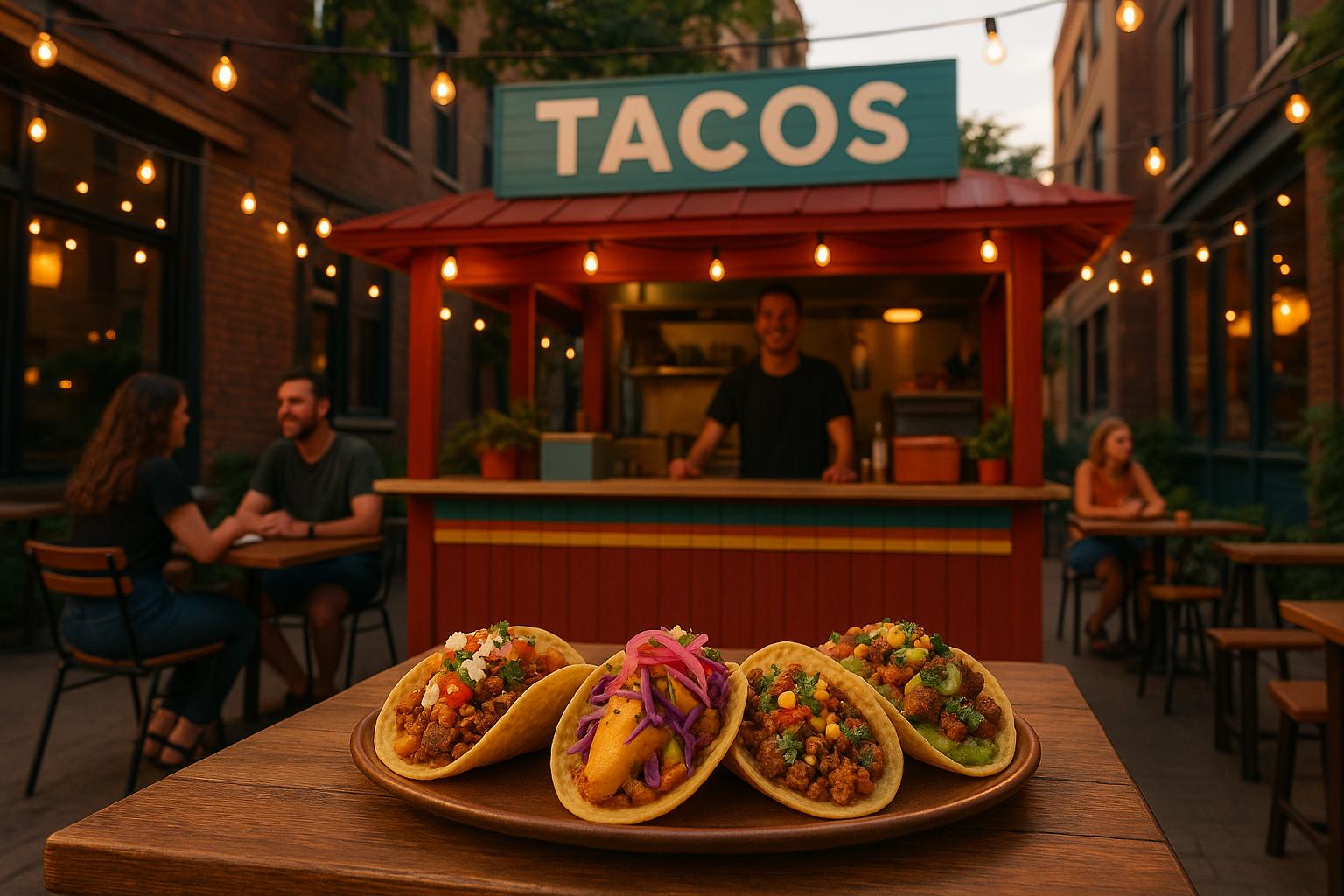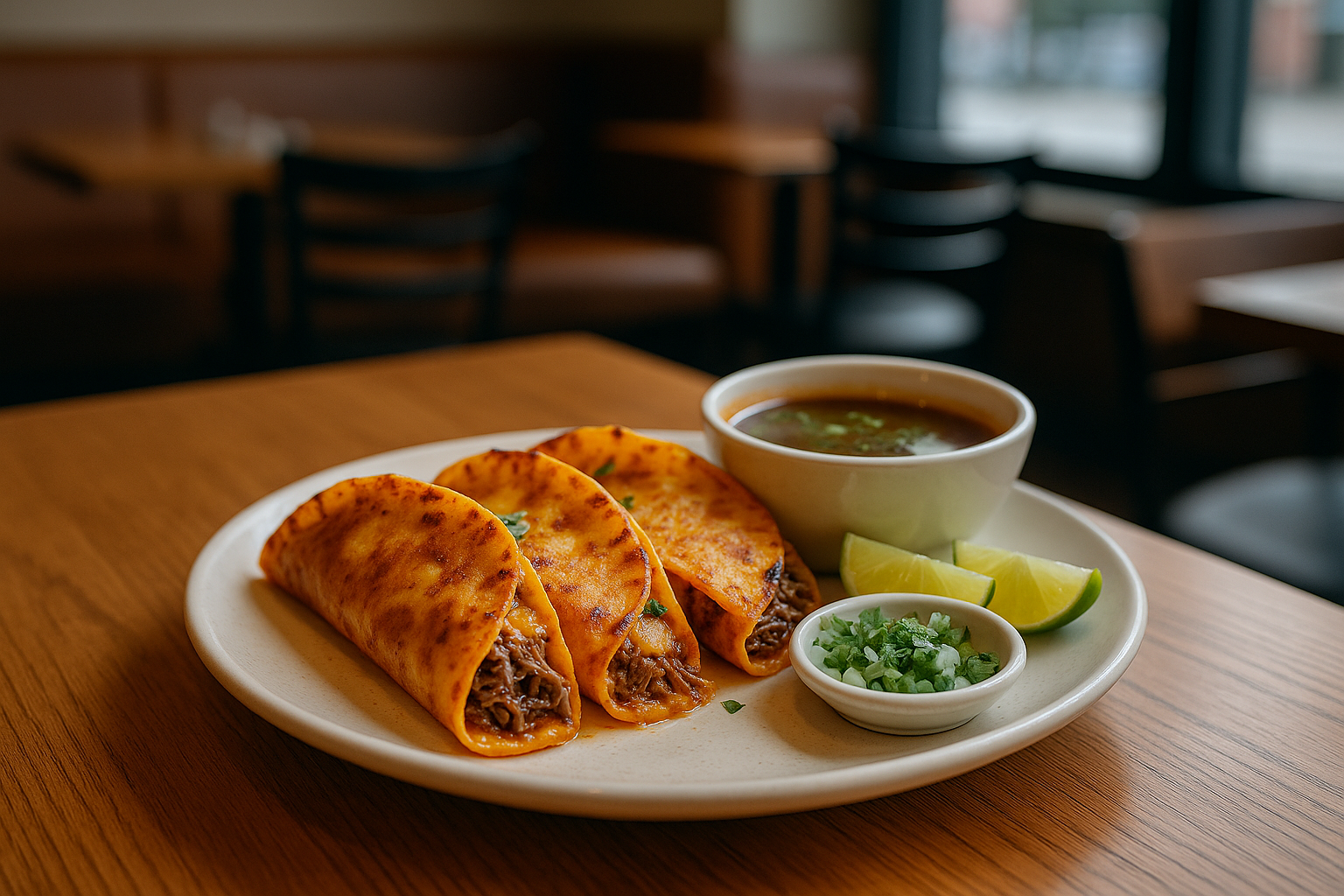When it comes to artisanal taco shells, the choice between corn and flour tortillas depends on your taste preferences, dietary needs, and the type of taco you’re making. Here’s a quick breakdown:
-
Corn Tortillas:
- Flavor: Earthy, toasted, and slightly sweet, thanks to nixtamalization.
- Texture: Dense, sturdy, and crisps well when fried.
- Size: Smaller (6 inches), ideal for street tacos.
- Nutrition: Lower in calories and fat, higher in fiber, and naturally gluten-free.
- Best For: Traditional fillings like grilled meats, bold spices, and gluten-free diets.
-
Flour Tortillas:
- Flavor: Mild, slightly buttery, with no fermented taste.
- Texture: Soft, pliable, and holds larger portions without tearing.
- Size: Larger (8–10 inches), perfect for hearty tacos.
- Nutrition: Higher in calories, protein, and fat, with more iron and calcium.
- Best For: Tex-Mex dishes, fusion tacos, and recipes needing a flexible wrap.
Quick Comparison Table
| Factor | Corn Tortillas | Flour Tortillas |
|---|---|---|
| Flavor | Earthy, toasted, slightly sweet | Mild, slightly buttery |
| Texture | Dense, sturdy, crisps well | Soft, pliable, holds larger fillings |
| Size | ~6 inches | 8–10 inches |
| Calories (per 100g) | 159 | 304 |
| Fiber | 4.5g | 1.8g |
| Protein | 4.55g | 8.93g |
| Best For | Street tacos, gluten-free diets | Tex-Mex, hearty tacos, fusion dishes |
Corn tortillas bring a traditional flavor and crisp texture, while flour tortillas are soft, flexible, and great for larger or more creative tacos. Whether you prefer one over the other, Chicago’s taco scene offers plenty of options to explore both styles.
Corn as a Base for Artisanal Taco Shells
Flavor Profile and Texture
Corn tortillas bring a naturally earthy and subtly sweet flavor, thanks to the process of nixtamalization. This traditional method involves treating corn kernels with lime water before grinding, giving the tortillas a rich depth that pairs beautifully with classic taco fillings.
Their texture is equally noteworthy - rustic and sturdy. Corn tortillas maintain their structure when filled, and when warmed properly, they develop a satisfying chewiness that enhances every bite. Their smaller size compared to flour tortillas makes them perfect for street-style tacos, allowing you to enjoy a variety of flavors in one sitting without overindulging.
This hearty texture works especially well with grilled meats, spicy salsas, and bold seasonings. The earthy undertones of corn tortillas amplify smoky and spicy flavors while letting the core ingredients shine. These qualities are rooted in centuries of tradition, making them an essential part of authentic taco experiences.
History and Background
Corn tortillas have been a cornerstone of cuisine in the Americas for thousands of years, dating back to pre-Columbian times. Historical records even describe Emperor Moctezuma using corn tortillas as edible utensils, underscoring their importance in Aztec culinary practices [6].
Maize, the crop behind these tortillas, holds deep cultural significance in Mexico and Central America. It's more than just a food staple - it's a symbol of identity. Today, Mexico cultivates over 42 varieties of maize [5], each adding its own distinct flavor and texture to regional tortillas.
When Spanish colonizers arrived, they named these corn flatbreads "tortillas" because of their resemblance to Spanish flat, round omelets. Despite this European naming influence, indigenous preparation methods and cultural importance have endured. This rich history is what fuels today’s resurgence of artisanal taco shells, honoring centuries of tradition.
Nutritional Benefits
Corn tortillas aren’t just flavorful - they’re a smart choice for health-conscious eaters. As a whole grain option, they deliver key nutrients while being lower in calories and fat compared to flour tortillas [4]. For example, a 44-gram corn tortilla contains about 96 calories, 2.8 grams of fiber, and 31.7 mg of magnesium [4]. The fiber aids digestion and helps stabilize blood sugar, and with just 19.8 mg of sodium, they are a lower-sodium alternative to many flour tortillas.
They are also naturally gluten-free, making them a safe option for those with celiac disease or gluten sensitivities [4]. Beyond that, corn tortillas provide a good source of fiber and magnesium while offering fewer calories, carbs, and fat than their flour-based counterparts [4].
With their nutritional perks, authentic flavor, and connection to tradition, corn tortillas are the perfect foundation for artisanal taco shells that deliver on both taste and health.
Flour as a Base for Artisanal Taco Shells
Flavor Profile and Texture
Flour tortillas bring a mild, slightly buttery flavor that acts as a perfect base for bold, flavorful fillings. Their light and tender texture, combined with a pliability that resists tearing, makes them ideal for holding generous portions. With their larger size - typically 8 to 10 inches compared to the 6-inch standard for corn tortillas - they're well-suited for creative and hearty taco combinations. This balance of subtle flavor and reliable structure has allowed flour tortillas to carve a unique space in the evolution of modern taco culture.
Modern Development and Uses
Flour tortillas have come a long way, especially within Tex-Mex cuisine, where the availability of wheat flour spurred their rise. Over time, they’ve become a staple in American kitchens, thanks in part to key players like GRUMA, which launched Mission Tortillas in 1977, and Chicago entrepreneur Art Velasquez, who founded Azteca Foods in 1970. These contributions helped popularize flour tortillas, paving the way for their use in everything from upscale street tacos to plant-based and fusion-inspired creations.
Today, the tortilla industry is valued at around $25 billion, with a steady growth rate of 5% [10]. This growth reflects not only national trends but also the vibrant taco culture in cities like Chicago, where innovation thrives. Despite their strong association with Tex-Mex cuisine, flour tortillas remain deeply rooted in Mexican culinary traditions. As cookbook author and TV host Pati Jinich notes:
"Flour tortillas are very Mexican. I don't choose one over the other, at all, just like any Mexican." [9]
Nutritional Considerations
When it comes to nutrition, flour tortillas pack more calories and fat compared to their corn counterparts. A 100-gram serving of flour tortillas contains 304 calories, 8.93 grams of protein, 8.04 grams of fat, 48.21 grams of carbohydrates, and 1.8 grams of fiber [8]. In contrast, corn tortillas provide 159 calories, 4.55 grams of protein, 2.27 grams of fat, 43.18 grams of carbohydrates, and 4.5 grams of fiber [8]. The higher calorie count in flour tortillas is often attributed to ingredients like lard or shortening [8], but they also offer more iron and calcium. For tacos that require a heartier base, this extra energy can be a plus - especially when whole wheat varieties are chosen for their added nutritional benefits.
Corn vs. Flour: Comparison Table
Comparison Table
Deciding between corn and flour tortillas for your taco dish? Here's a detailed side-by-side comparison to help you choose the perfect base.
| Factor | Corn Tortillas | Flour Tortillas |
|---|---|---|
| Flavor Profile | Toasted corn taste with an earthy, robust character [1] | Slightly sweet, with a mild and subtle flavor [1] |
| Texture | Denser and sturdier; can become grainy as they cool [1][3] | Softer, more pliable, and maintains a smooth texture even when cooled [1][3] |
| Size | Typically around 6 inches in diameter | Usually 8–10 inches in diameter |
| Flexibility | Harden and crisp when fried or dried [2] | Stay flexible and soft, even after cooling [2] |
| Cultural Heritage | Rooted in ancient Mesoamerica (circa 800–1000 BC); the quintessential Mexican tortilla [2][7] | Introduced by Spanish colonizers in the 16th century; widely favored in northern Mexico [7] |
| Traditional Uses | Perfect for tacos, enchiladas, tostadas, and totopos [2][7] | Best suited for burritos, quesadillas, fajitas, and dishes like queso fundido [2][7] |
| Calories (per 100g) | 159 calories [8] | 304 calories [8] |
| Protein | 4.55g [8] | 8.93g [8] |
| Fat | 2.27g [8] | 8.04g [8] |
| Fiber | 4.5g [8] | 1.8g [8] |
| Key Minerals | Higher in magnesium [4] | Contains more iron and calcium [8] |
| Gluten Content | Naturally gluten-free [8] | Contains gluten [4] |
| Portion Control | Smaller size helps with portion management [4] | Larger size allows for more generous fillings |
| Best For | Traditional Mexican dishes, gluten-free diets, and crispy shell recipes | Tex-Mex cuisine, soft tacos, and recipes that need a larger, more flexible wrap |
Corn tortillas bring an authentic, earthy flavor and a crisp texture, making them a great choice for traditional street tacos or gluten-free diets. On the other hand, flour tortillas offer a mild flavor, larger size, and flexibility, perfect for hearty Tex-Mex dishes or soft tacos. In Chicago's vibrant taco scene, chefs often use both types to craft unique and tailored creations, blending tradition and innovation in every dish.
sbb-itb-8621021
Uses and New Ideas in Chicago
Classic and Modern Pairings
Chicago's taco scene is a vibrant mix of tradition and creativity, where chefs carefully choose between corn and flour tortillas to bring their taco visions to life.
Corn tortillas remain a cornerstone of classic recipes. At Taqueria Chingón in Bucktown, they use thick, speckled corn tortillas made from masa sourced from Chepe's Tortillas in Cicero. Owner Marcos Ascencio serves up both traditional al pastor tacos and imaginative options like vegetarian tacos featuring celery root and portobello mushrooms, or duck carnitas paired with date puree and habanero sunchoke salsa [11].
"I was trying to figure out a nice size that would travel well. The worst thing is if the tortillas are cold and fall apart." – Marcos Ascencio, Taqueria Chingón [11]
Jarabe Mexican Street Food elevates corn tortilla craftsmanship even further, using heirloom corn from Masienda to create tortillas that are both elastic and fragrant. Their fish tacos Ensenada, served on blue corn tortillas, combine fried cod, pico de gallo, red cabbage, and chipotle mayo [11]. Chef Alexis Vejar speaks to the difference heirloom corn makes:
"The final product is so much better because of the heirloom corn." – Alexis Vejar, Jarabe Mexican Street Food [11]
On the other hand, flour tortillas shine in fusion dishes where their soft texture and subtle flavor complement bold, international combinations. Evette's in Lincoln Park takes a Middle Eastern-Mexican approach with their chicken arabes tacos, wrapping al pastor-style chicken in flour tortillas alongside cucumber labneh and Aleppo pepper hot sauce. The mildness of the flour tortilla allows these flavors to shine without overpowering them [11].
Across Chicago, chefs are experimenting with hybrid approaches to tacos. Wild Taco in Old Town mixes traditional and modern influences, offering a standout duck taco featuring shredded duck confit, mole negro, and banh mi-inspired toppings, all on a fresh corn tortilla [11]. Meanwhile, Takito Kitchen in Wicker Park pushes boundaries with specialty tortillas, such as sesame tortillas for pork belly tacos and traditional corn tortillas for lamb chorizo tacos topped with tomatillo pistachio salsa [13].
Another trend making waves is the petite taco, where smaller sizes pack a big flavor punch. Taquizo's carne asada quesatacos, for instance, roll grilled steak in crispy cheese on thin corn tortillas, delivering bold flavors in a compact format [11]. These innovations highlight the importance of choosing the right tortilla - corn or flour - as the foundation for artisanal tacos.
This rich diversity in taco preparation sets the stage for exploring Chicago's best spots to enjoy these creations.
Finding Chicago's Taco Spots
With over 2,500 registered Mexican restaurants in Chicago [14], finding the perfect taco might feel like a daunting task. That’s where Chicago Taco Spot (https://chicagotacospot.com) comes in, offering a complete guide to the city's taco scene. The platform helps taco enthusiasts discover restaurants that excel with both corn and flour tortillas.
The directory points out neighborhoods known for their taco offerings. Little Village's 26th Street corridor is packed with traditional taquerias where handmade corn tortillas are the standard. Meanwhile, areas like Wicker Park and Lincoln Park are home to experimental spots that embrace flour tortillas for creative fusion dishes [12] [14].
Volume and consistency often signal quality. For example, Taqueria El Milagro serves over 500 steak tacos daily [14], a testament to their popularity and reliability. Known for their house-made flour tortillas, this spot is a must-visit for anyone seeking top-notch flour tortilla tacos [12].
Chicago Taco Spot also features a user recommendation system, making it easier to uncover hidden gems and rising trends. For instance, Taylor's Tacos in East Garfield Park, available at Dock's Fish in Bronzeville, showcases inventive tacos like asparagus tacos on corn tortillas alongside classic fish tacos [11].
The city’s taco scene caters to all budgets, from affordable neighborhood joints to upscale, chef-driven concepts [14] [15]. The platform helps diners find the best value, whether they’re after authentic street-style tacos or elaborate tasting menus like taco omakase experiences [15].
Chicago Taco Spot also tracks seasonal trends and new developments in the taco world. With breakfast tacos gaining traction on menus across the city [16], the directory highlights where to find the best morning tacos, whether they’re built on corn or flour tortillas. This evolving culinary landscape ensures there’s always something new to discover in Chicago’s taco scene.
Whole Grain Corn Versus Refined Flour Tortillas (700 Calorie Meals, DiTuro Productions LLC)

Conclusion
When it comes to choosing between corn and flour tortillas for artisanal taco shells, it really depends on the style and flavor you're after. Each option brings its own charm to the table, enhancing your taco experience in unique ways.
Corn tortillas deliver that classic, earthy flavor, thanks to the nixtamalization process that gives them their distinct character. They crisp up wonderfully when fried, making them ideal for traditional recipes. On the other hand, flour tortillas offer a mild, wheat-forward taste and a soft, flexible texture. This makes them perfect for holding heavier fillings and staying pliable, even after cooling.
From a nutritional perspective, corn tortillas are a lighter option, while flour tortillas pack in more protein and nutrients. These differences play a big role in the regional taco styles of Mexico. For example, northern Mexican and Tex-Mex dishes often lean on flour tortillas, while corn tortillas dominate in central and southern Mexican cuisine. Chicago’s taco scene reflects this diversity, embracing both styles and showing how tortilla choices influence the city’s culinary creativity.
The best way to find your favorite? Dive in and try them both. Chicago’s taco spots offer a wide range of options that highlight the strengths of each tortilla type. Whether you’re exploring traditional flavors or modern takes, there’s plenty to discover.
Ready to start your taco adventure? Check out Chicago Taco Spot for a guide to restaurants that excel with both corn and flour tortillas. It’s the perfect way to explore the city’s vibrant and delicious taco culture.
FAQs
What are the health benefits of choosing corn tortillas over flour tortillas for tacos?
Corn tortillas come with a handful of health perks that make them stand out from their flour counterparts. For starters, they’re naturally lower in calories, packing about 50 calories per ounce, compared to the 100 calories per ounce you’ll typically find in flour tortillas. On top of that, they’re richer in dietary fiber, which not only aids digestion but also helps you feel fuller for longer.
Another bonus? Corn tortillas are lower in fat and sodium, which makes them a heart-friendly option. Plus, since they’re gluten-free, they’re a go-to choice for anyone with gluten sensitivities. Thanks to the traditional nixtamalization process used in their preparation, corn tortillas also offer better nutrient absorption, especially for calcium and magnesium, two minerals that are key to keeping your bones strong. If you’re aiming to make your tacos healthier, corn tortillas are a smart pick.
What is nixtamalization, and how does it improve the flavor and texture of corn tortillas?
Nixtamalization is an age-old technique where corn is cooked and soaked in an alkaline solution, typically limewater. This process not only softens the kernels for easier grinding into masa - the dough essential for making tortillas - but also enhances their flavor, giving tortillas that deep, earthy taste we all recognize and love.
But it’s not just about taste. Nixtamalization also improves the texture of tortillas, making them flexible yet strong enough to hold fillings without falling apart. On top of that, it increases the nutritional benefits of corn by unlocking niacin (vitamin B3), a vital nutrient for maintaining good health. This time-honored method is at the heart of crafting authentic, flavorful, and wholesome corn tortillas.
Why are flour tortillas more common in Tex-Mex and fusion tacos than corn tortillas?
Flour tortillas are a favorite in Tex-Mex and fusion tacos, thanks to their soft and flexible texture. Their mild flavor works beautifully with a wide range of fillings and sauces, making them a versatile option for taco lovers. Plus, their elasticity is a game-changer - it allows them to handle heavier or saucier fillings without tearing, which means a more enjoyable and mess-free eating experience.
In Tex-Mex cuisine, flour tortillas are a cornerstone ingredient, commonly featured in burritos and quesadillas. Their sturdy structure makes them perfect for holding dense or unconventional fillings, which is why they’re often the top pick for fusion-style tacos that experiment with bold, non-traditional combinations.


